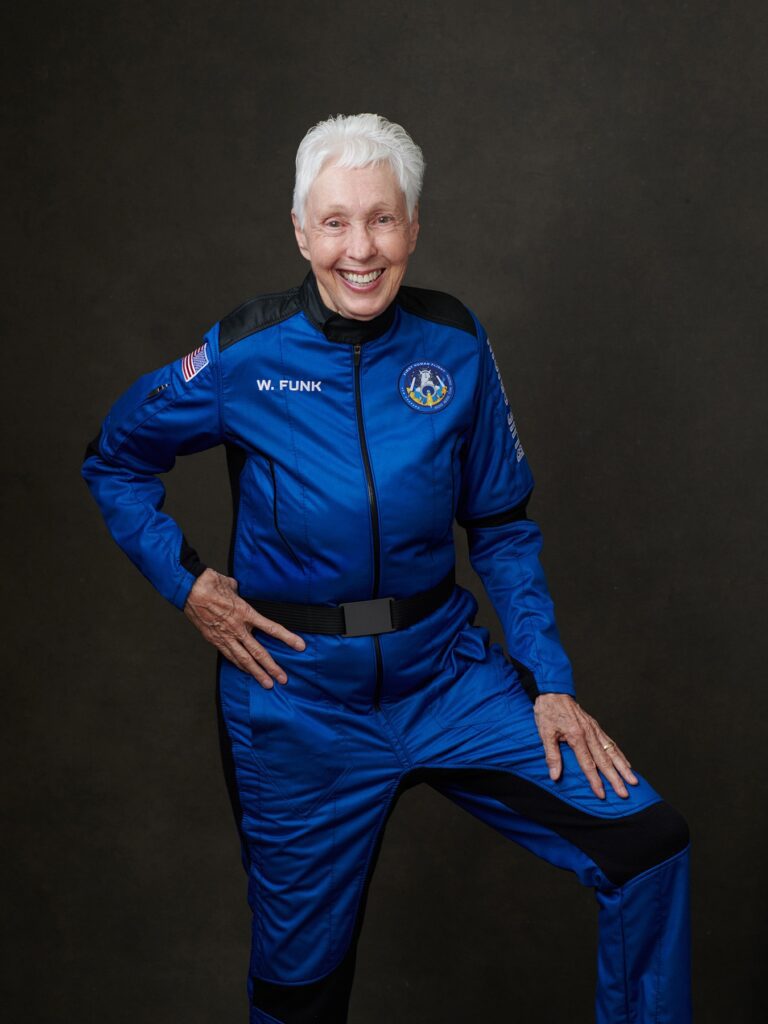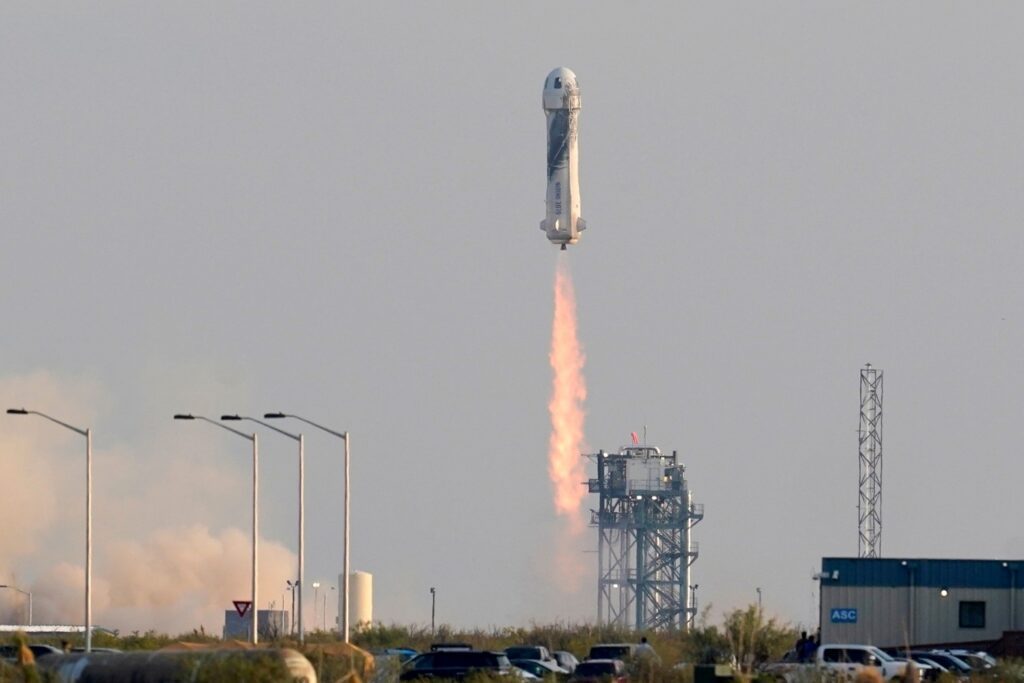Wearing earplugs, a swimsuit, and a belt made of foam rubber that cradled the small of her back, Wally Funk stretched out in the water, spread-eagle, and got comfortable. Then it hit her: She couldn’t feel a thing. She splashed some water on her face — still nothing.
Prior to getting into the sensory deprivation tank, the researchers instructed Funk to lay there as long as she could. So that’s exactly what she did — for 10 hours and 35 minutes.
“This is what they thought space travel would be like,” Funk says in a 2018 documentary. “So I lay there. I think I fell asleep, maybe for a minute or so. I was thinking about how wonderful it would be to be up there and feel the lightness. It was freedom.”
It was 1961, and at the age of 22, Mary Wallace “Wally” Funk was the youngest of a group of 13 elite women pilots selected to undergo the same series of medical and psychological tests given to the seven men slated to travel to space as part of Project Mercury: NASA’s first human spaceflight program. Known collectively as the Fellow Lady Astronaut Trainees (FLATs), Funk and the 12 other women consistently outperformed men who would go on to become astronauts and instant national heroes, like John Glenn and Alan Shepard.
But, for a variety of reasons, including Cold War politics and good-old-fashioned misogyny, none of the FLATs ever made it into space. That is, until this morning, when, at the age of 82, Funk became the oldest person to travel to space — a full 60 years after proving she had what it takes to be an astronaut. Here’s a look at the legendary career in aviation that brought her to this point.
A lifelong career in flight
When Amazon and Blue Origin founder Jeff Bezos asked Funk to join him on his upcoming 11-minute suborbital spaceflight, she didn’t think twice about the invitation, or her willingness to fly commercial. In fact, in 2010, Funk used her life savings to put a deposit of $200,000 on a ticket for a future Virgin Galactic flight — a trip that she’s still planning to take, her agent recently told Insider. Traveling to space has been a lifelong dream for Funk, and she had no plans to let her gender or age stand in her way.
Born in New Mexico in 1939, Funk’s first exposure to the world of aviation came before her first birthday, when her parents brought her to a local airport and she had the opportunity to sit at the wheel of a Douglas DC-3, a propeller-driven airliner, The Guardian reports. As a child, Funk was interested in mechanics, and practiced flying by jumping off her family’s barn wearing a Superman cape. Her official training began when she was a teenager, and she received her pilot’s license at the age of 17. By the time she was 20, Funk was working as a civilian flight instructor at Fort Sill, Oklahoma. A year later, she set her sights on space.

Wally Funk
Blue Origin
A woman’s place is in space
After creating and conducting the medical and psychological tests given to the first astronaut candidates in the United States (all of which were men) in 1959, Dr. William Randolph “Randy” Lovelace II, along with former flight surgeon Brig. General Donald Flickinger, wanted to see how women would perform on the same exams. But according to Dr. Amy Foster, an associate professor of history at the University of Central Florida, specializing in gender and the history of aviation and the U.S. space program, their research was rooted in science, rather than activism.
“Because women tend to be smaller, they tend to weigh less, and that’s a really important element of spaceflight,” she tells Rolling Stone. “For every pound of cargo — and that means anything that’s not equipment that you need — it essentially takes three pounds of fuel. So not only do women weigh less, women eat less food, women drink less water, and they use less oxygen — and that’s all cargo. And so from a physiological standpoint, there is financial and technological benefit to flying smaller people.”
Today, the group of women who participated in Lovelace’s “Women in Space” program is widely known as the “Mercury 13” — a name that Foster says is a misrepresentation of the privately funded program, given that it wasn’t actually affiliated with NASA’s Project Mercury. “It has always been outside of NASA,” she explains. “NASA wasn’t funding it, they weren’t monitoring it — it was not their program.”
In fact, because of the informal nature of the testing, the 13 women involved weren’t given an official name, Foster says. The “FLATs” moniker emerged when Geraldyn “Jerrie” Cobb — the first woman selected to undergo the tests — used the term in the letters she sent to her fellow pilots inviting them to the Lovelace Clinic, she notes.
But even without a formal title or NASA affiliation, the FLATs made history. “These were women who, in the early 1960s, attempted to break the gender barrier in astronaut training in the United States,” says Dr. Janet Bednarek, an aviation historian and professor of history at the University of Dayton. “Sixty years ago, when someone said, ‘You can’t do that — you’re a girl,’ it was really true.”
A question of qualifications
Ultimately, Funk and the other FLATs answered Lovelace’s question of whether — in addition to reducing the amount of fuel required for a space flight — women could meet the physical and psychological challenges predicted to be a part of space travel. But despite performing as well as or better than the men of Project Mercury, the women were immediately met with opposition, including from then-Vice President Lyndon B. Johnson, who scrawled “Let’s stop this now!” on a letter discussing the FLATs.
In the summer of 1962, the FLATs received telegrams informing them that the next phase of their testing — advanced aeromedical examinations — had been cancelled, only days before they were to report to Pensacola, Florida. These tests required the use of military equipment and jet aircraft, but without the backing of NASA, the Navy refused to grant Lovelace and the FLATs use of their facilities.
Two of the FLATs immediately traveled to Washington, D.C. to make their case in front of Congress, and continued to be met with opposition. NASA representatives testified that women did not meet the qualifications necessary to become an astronaut, with Glenn going as far as saying that “the fact that women are not in this field is a fact of our social order.”
In reality, NASA made it impossible for women to qualify as astronauts. “NASA, at that point, said they needed people with jet pilot experience,” Foster explains. “But the only way to access jets was through the military, and women were excluded from those roles in the military at the time.”
Undeterred by this setback, Funk continued her trailblazing career as a pilot, becoming the first woman to reach a number of aviation accomplishments, including completing the Federal Aviation Administration’s (FAA) General Aviation Operations Inspector Academy course, working as an FAA field examiner, and serving as an air safety investigator with the National Transportation Safety Board (NTSB). She also never lost sight of her goal of space travel, applying to become a NASA astronaut four times over the next several years, though she was never selected.
After retiring from the NTSB in 1985, Funk returned to her roots as a flight instructor. To date, she has logged more than 19,600 flying hours, and taught roughly 3,000 people to fly.

Blue Origin’s New Shepard rocket launches carrying passengers Jeff Bezos, brother Mark Bezos, Oliver Daemen and Wally Funk, from its spaceport near Van Horn, Texas, on Tuesday, July 20th, 2021.
Tony Gutierrez/AP
A different historic spaceflight
When Sara Fisher, executive director of the International Women’s Air and Space Museum in Cleveland, Ohio, and her colleagues first heard that Funk would be making her historic trip to space, they didn’t believe it.
“We honestly thought that it was a prank until we started seeing the news blow up here,” she tells Rolling Stone. “There was a lot of happy laughter and squeals and excitement. We love Wally — she is truly a gem — and there aren’t words to describe how elated and humbled we are to see all of her work come to fruition.”
Even before the news of Funk’s spaceflight, Fisher says that there was increased interest in the FLATs at the museum this year because it’s the 60th anniversary of the testing program. But as of today, their existing display on the women dubbed the “Mercury 13” contains a welcome inaccuracy. “We are so looking forward to updating our exhibit [on the FLATs],” she says. “Now, we can no longer say that none of the women became astronauts, because we are in this new era, and Wally is helping to pave the way.”
And that’s not the only history Funk made today: at 82, she became the oldest person to go to space — breaking the record Glenn set in 1998 at the age of 77. “The fact that this is a woman in her 80s getting a chance [to travel to space] is pretty extraordinary, and talks about not only her persistence, but also the changing ideas of aging,” Foster says. “And that Funk’s as fit to do this as anybody else.”
Moreover, Bednarek sees a connection between the testing Funk went through as a FLAT in the early 1960s, and today’s commercial space tourism — both of which aimed to make space travel accessible to more people. “Wally Funk is kind of bridging two periods when people are trying to open up spaceflight to those beyond a certain group of very elite male military test pilots,” Bednarek tells Rolling Stone. “She was there in the 1960s, and here she is now in 2021, doing it as well.”
Bednarek hopes that Funk’s trip to space will spark interest in careers in aviation in another generation — particularly among women, who she says are “still desperately underrepresented” in the field. “If aviation and aerospace are going to continue, it needs all the talent, all the brainpower, all the enthusiasm it can get,” she says. “And by not drawing on half the human population, they’re missing out on a lot.”

